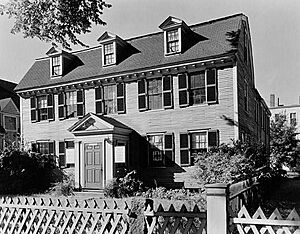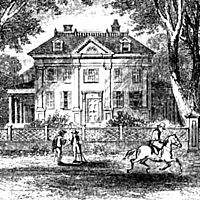Brattle Street (Cambridge, Massachusetts) facts for kids

42 Brattle Street, whose Loyalist owner William Brattle gave the street his name
|
|
| West end | Mt. Auburn Street |
|---|---|
| East end | Massachusetts Avenue |
Brattle Street in Cambridge, Massachusetts, is a very old and famous street. Before the American Revolutionary War, people called it the "King's Highway" or "Tory Row". This street is home to many important historical buildings.
You can find a modern glass-and-concrete building that used to be the Design Research store here. There's also a beautiful old mansion where both George Washington and the famous poet Henry Wadsworth Longfellow lived at different times. A historian once said that Brattle Street is "not only one of the most beautiful but also one of the most historic streets in America." It has always been a very fancy place to live!
Contents
How Brattle Street Began as a Forest Path
Long before Cambridge was even called "Newe Towne," there was a path. This path connected Charlestown to Watertown. It ran right through where Harvard Square is today and continued along much of what we now call Brattle Street.
In the early 1600s, Newe Towne had a few houses. Behind them was a thick forest. The path through this forest was the very first main road from the coast into the country. Where Ash Street meets Brattle Street now, there was once a "West Gate." This was a fence built to keep farm animals from wandering into town.
Brattle Street in the 1700s: "Tory Row"
During the 1700s, seven large mansions were built along the main road to Watertown. This road included both today's Brattle Street and Elmwood Avenue. Many of the people who owned these houses were Loyalists. This meant they supported the British King during the American Revolution. Because of this, the area became known as "Tory Row."
When the Revolution started, George Washington's army took over many of these houses. Later, some were given back to the families who owned them before the war. Even with these big houses, the forest was still very close by. In 1759, a student wrote that "many bears" were seen and even killed in Cambridge!
William Brattle was a leader of the local army and one of the richest men in the area. The street is named after him. He had his house at 42 Brattle Street built in 1727. Brattle tried to keep peace between the American patriots and the British. But after an event called the Powder Alarm in 1774, an angry crowd surrounded his house. He was forced to leave.
A German noblewoman named Frederika Charlotte Riedesel lived at 149 Brattle Street during the war. Her husband was a general helping the British. She wrote about how lovely Brattle Street was before the war. She described seven families, all friends or relatives, living in beautiful homes with gardens. They would meet daily for music and dancing. She said they were "living in prosperity, united and happy, until, alas! this ruinous war separated them."
105 Brattle Street: Washington and the Longfellows
Another Loyalist who left Cambridge in 1774 was John Vassall Jr. He owned the beautiful yellow Georgian house at 105 Brattle Street, built in 1759. When he left, the house was empty.
In 1775, George Washington moved into this house. He made it his headquarters for the Continental Army. Washington used the rooms on the southeast corner for his own living space. His wife, Martha Washington, joined him there in December 1775. Washington lived in the house until July 1776.
Many years later, in 1837, a young Harvard professor named Henry Wadsworth Longfellow rented rooms in the house. It was then a boarding house run by the widow of Washington's doctor. Longfellow was very proud to live there. He wrote to a friend, "I live in a great house which looks like an Italian villa: have two large rooms opening into each other. They were once Gen. Washington's chambers."
In 1843, Longfellow's father-in-law gave him the house as a wedding gift. Longfellow married Frances Appleton, and they made it their home. Frances was the first American woman to receive medicine to help with pain during childbirth. She gave birth to her children right there at 105 Brattle Street.
Longfellow and Frances had two sons and three daughters. His poem "The Children's Hour" is about his daughters: "grave Alice, and laughing Allegra, and Edith with golden hair." All three daughters later had houses on Brattle Street. Alice inherited her parents' home. Allegra and Edith had stylish homes built for them at 113 and 115 Brattle Street in 1887.
Brattle Street in the 1800s
At the start of the 1800s, only a few more houses were added to Brattle Street. The south side of the street was still mostly "meadow-land and orchards."
Between 1805 and 1812, a decision was made to straighten the end of Brattle Street. This part joined Mount Auburn Street. A section of the old "Tory Row" was renamed "Elmwood Avenue." So, today's Brattle Street is a bit different from the original road to Watertown. That old road actually went along what is now Elmwood Avenue.
As the 1800s continued, wealthy families kept building homes on Brattle Street. They chose the newest styles of architecture. These included Greek Revival (like #112 built in 1846), Stick style (#92, built in 1881), and Colonial Revival (#115, built in 1887). The Shingle style Mary Fiske Stoughton House at 90 Brattle Street is considered one of the best wooden houses in America.
Brattle Street After 1900
In 1969, the Design Research store built a unique four-story building at 48 Brattle Street. It was made of glass and concrete in a Modernist style. The store had been selling cool Scandinavian clothes and home goods on Brattle Street since 1953.
Today, during the summer, Harvard Square and Brattle Square are lively places. You can often see street performers and musicians there. At One Brattle Square, there's a small brass sculpture called the Fokin Memorial. It's a tribute to a favorite puppet used by a puppeteer named Igor Folkin.
Notable Sites on Modern Brattle Street
- 40: Brattle Hall*
- 42: William Brattle House*^
- 48: Modern glass and concrete building built in 1969 for the Design Research store
- 54: Dexter Pratt House*
- 64: American Repertory Theatre
- 85: The Norton-Johnson-Burleigh House (1847)
- 90: Mary Fiske Stoughton House*
- 92: The Misses Sarah and Emma Cary House (1881), a Stick style home
- 94: The Henry Vassall House^
- 99: The former Episcopal Divinity School, founded in 1867
- 101: Oliver Hastings House*
- 105: Former home of John Vassall and Henry Wadsworth Longfellow, also known as the "Vassall-Craigie-Longfellow House," now the Longfellow House–Washington's Headquarters National Historic Site^
- 112: Greek Revival house (1846)
- 113: The Edith Longfellow Dana House (1887)
- 114: Neo-Georgian house (1903)
- 115: Annie Longfellow Thorp House (1887), a Colonial Revival house built for Longfellow's daughter Annie Allegra
- 149: Lechmere-Sewall house, also known as the "Lechmere-Riedesel House"^
- 159: Hooper-Lee-Nichols House, home of the Cambridge Historical Society^
- 175: Ruggles-Fayerwether House^
- Footnote: Items marked with * are also listed on the National Register of Historic Places listings in Cambridge, Massachusetts. The entire Old Cambridge Historic District, which includes parts of Brattle Street, is also on this Register. Items marked with ^ are among the seven "Tory Row" houses mentioned by Samuel Atkins Eliot in 1913.
See also


